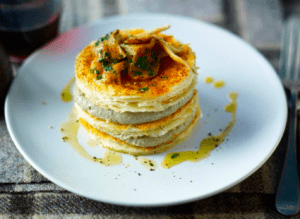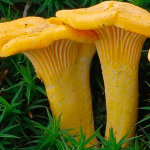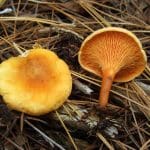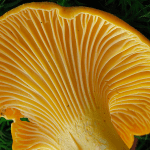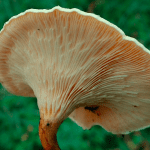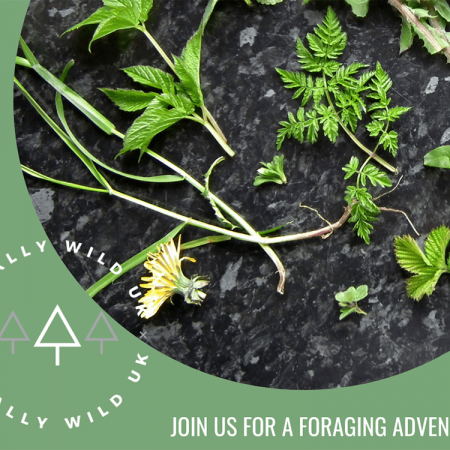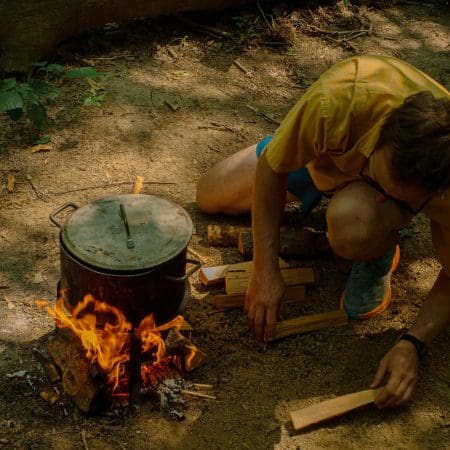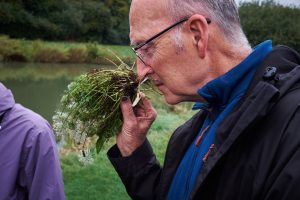True Chanterelles or False Chanterelles – it’s a question we might find asking ourselves when we’re out foraging for Chanterelles, to help you forage for the right thing we’ve put together a full piece outlining the key differences between the two.
At first glance, it’s easy enough to see how these two could get confused for each other. Closer examination, however, reveals some quite significant differences.
Let’s start with the absolute basics. Firstly, they belong to separate taxonomic families.
Chanterelles are members of the Cantherellaceae family. False Chanterelles are Hygrophoropsidaceae.
Let’s look a bit closer
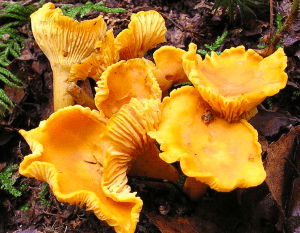
Cantharellus cibarius, also known simply as Chanterelles or Girolles, (in France), are an excellent edible mushroom.
Cap
Irregular shaped, almost flat when young but becomes distinctly trumpet shaped as they mature.
Gills
It doesn’t actually have true gills, they are folds or ridges and they run part way down the stem, (decurrent).
Spores
Yellow to cream.
Stem
The stem tapers at the base.
Smell
Slightly sweet and fruity when first picked. Some say it smells like Apricot.
Habitat
Cantharellus cibarius is a mycorrhizal fungi. This means it forms mutually beneficial relationships with the trees it grows alongside. You’ll find it growing in both coniferous and deciduous woods, in mossy leafy places. It’s sociable mushroom, growing happily alongside Birch, Beech, Alder, Scots Pine, Spruce and Fir. If anyone has found it growing alongside other trees, do let us know.
The cap, ridges and stem are all the same golden yellow colour. If you cut this mushroom in half, the flesh is white.
Now let’s take a look at the False Chanterelle
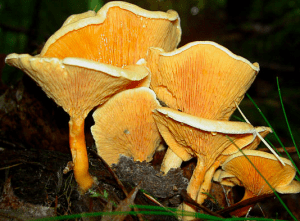
Hygrophoropsis aurantiaca, also known as False Chanterelles and Jack o’ Lantern, classed as poisonous, although not strictly as some cultures do eat this mushroom. Adverse symptoms can include upset digestion and hallucinations to name a few.
Cap
Yellow, yellow/orange/brown. Starting convex when young and slowly becoming shallowly funnel shaped with an in-rolled, undulating edge.
Gills
True gills, orange in colour, running part way down the stem, (decurrent), forked and crowded.
Spores
White.
Stem
Yellow/orange, tapering slightly towards the base, often curved.
Smell
Mild and of mushroom.
Habitat
This is a saprophytic mushroom, that obtains nutrients from leaf litter and decomposing wood. It seems to prefer coniferous woodland but it has been found growing in deciduous woods too and also, oddly, occasionally on heaths.
If you cut this mushroom in half, the flesh is pale yellow/orange and quite tough. It is never pure white.
Find our Full Guide for False Chanterelle Here
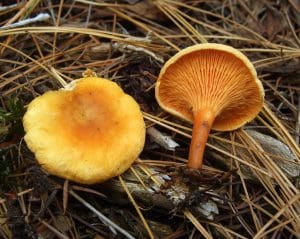
Summary of key differences between True Chanterelles or False Chanterelles
Cantharellus cibarius has false gills, that are folds and ridges, smells slightly sweet and fruity when freshly picked, is pale or golden yellow pretty much all over, with white flesh when cut.
Hygrophoropsis aurantiaca has true gills that are forked, crowded and orange, smells mild and mushroomy, with yellow/orange flesh when cut, NEVER pure white.
Ridges/folds of The gills of
True Chanterelle False Chanterelle
Although they do grow in similar habitats, you won’t find Cantharellus growing on Heaths.
Recipes for Chanterelles
Here’s one of the many delicious wild mushroom recipes you can find in our recipes section, wild mushroom and sage soup. You can use Chanterelles or whatever other mushrooms you have on hand for this delicious warming soup.
This next recipe is by Michel Roux Jnr, for the BBC Food website, Mushroom Millefeuille. It’s surprisingly simple to make and tastes amazing. If you happen to have a glut of Chanterelles you can use them to make your mushroom mousse too. This is a vegetarian recipe, but can easily be made vegan by replacing the butter and cream with plant based alternatives.
